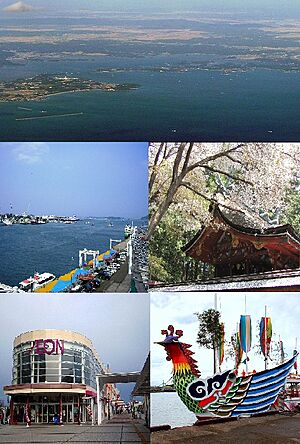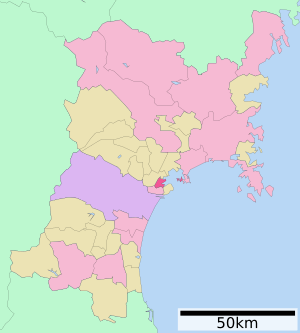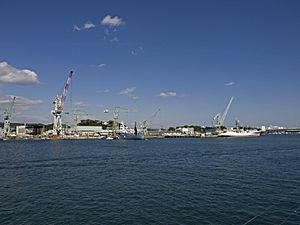Shiogama facts for kids
Quick facts for kids
Shiogama
塩竈市
|
|||||||||||
|---|---|---|---|---|---|---|---|---|---|---|---|

Urato islands
Shiogama Port, Shiogama Shrine Aeon Town Shiogama, Shiogama Port Festival |
|||||||||||
|
|||||||||||

Location of Shiogama in Miyagi Prefecture
|
|||||||||||
| Country | Japan | ||||||||||
| Region | Tōhoku | ||||||||||
| Prefecture | Miyagi | ||||||||||
| City Settled | November 23, 1941 | ||||||||||
| Area | |||||||||||
| • Total | 17.37 km2 (6.71 sq mi) | ||||||||||
| Population
(June 1, 2019)
|
|||||||||||
| • Total | 52,662 | ||||||||||
| • Density | 3,031.8/km2 (7,852.3/sq mi) | ||||||||||
| Time zone | UTC+9 (Japan Standard Time) | ||||||||||
| Phone number | 022-364-1111 | ||||||||||
| Address | 1-1 Asahimachi, Shiogama-shi, Miyagi-ken 985-8501 | ||||||||||
| Climate | Cfa | ||||||||||
| Website | http://www.city.shiogama.miyagi.jp/ | ||||||||||
|
|||||||||||
Shiogama (塩竈市 or 塩釜市, Shiogama-shi) is a city located in Miyagi Prefecture, Japan. As of June 1, 2019, about 52,662 people lived there. The city covers an area of about 17.37 square kilometers.
Contents
Exploring Shiogama's Location
Shiogama is in the northern part of Miyagi Prefecture. It sits right next to the Pacific Ocean on its eastern side.
Cities and Towns Nearby
Shiogama shares its borders with a few other places in Miyagi Prefecture:
- Rifu
- Shichigahama
- Tagajō
Shiogama's Climate and Weather
Shiogama has a mild climate. This means it has warm summers and cool winters. The average temperature for the year is about 11.8 degrees Celsius. September is usually the wettest month.
| Climate data for Shiogama (1991−2020 normals, extremes 1976−present) | |||||||||||||
|---|---|---|---|---|---|---|---|---|---|---|---|---|---|
| Month | Jan | Feb | Mar | Apr | May | Jun | Jul | Aug | Sep | Oct | Nov | Dec | Year |
| Record high °C (°F) | 14.4 (57.9) |
20.7 (69.3) |
21.3 (70.3) |
30.0 (86.0) |
30.9 (87.6) |
34.2 (93.6) |
35.5 (95.9) |
35.8 (96.4) |
35.7 (96.3) |
30.0 (86.0) |
23.5 (74.3) |
20.7 (69.3) |
35.8 (96.4) |
| Mean daily maximum °C (°F) | 4.4 (39.9) |
5.2 (41.4) |
8.9 (48.0) |
14.5 (58.1) |
19.3 (66.7) |
22.3 (72.1) |
25.7 (78.3) |
27.4 (81.3) |
24.1 (75.4) |
18.8 (65.8) |
13.0 (55.4) |
7.1 (44.8) |
15.9 (60.6) |
| Daily mean °C (°F) | 0.9 (33.6) |
1.3 (34.3) |
4.4 (39.9) |
9.6 (49.3) |
14.6 (58.3) |
18.3 (64.9) |
22.0 (71.6) |
23.5 (74.3) |
20.3 (68.5) |
14.8 (58.6) |
8.8 (47.8) |
3.4 (38.1) |
11.8 (53.3) |
| Mean daily minimum °C (°F) | −2.1 (28.2) |
−2.0 (28.4) |
0.5 (32.9) |
5.4 (41.7) |
10.8 (51.4) |
15.2 (59.4) |
19.3 (66.7) |
20.7 (69.3) |
17.2 (63.0) |
11.2 (52.2) |
5.0 (41.0) |
0.2 (32.4) |
8.5 (47.2) |
| Record low °C (°F) | −9.6 (14.7) |
−9.5 (14.9) |
−6.2 (20.8) |
−2.8 (27.0) |
0.5 (32.9) |
7.9 (46.2) |
11.1 (52.0) |
12.9 (55.2) |
6.9 (44.4) |
2.2 (36.0) |
−3.1 (26.4) |
−7.8 (18.0) |
−9.6 (14.7) |
| Average precipitation mm (inches) | 38.3 (1.51) |
31.8 (1.25) |
71.2 (2.80) |
87.9 (3.46) |
101.8 (4.01) |
130.0 (5.12) |
170.2 (6.70) |
130.5 (5.14) |
172.1 (6.78) |
140.2 (5.52) |
60.3 (2.37) |
40.6 (1.60) |
1,175 (46.26) |
| Average precipitation days (≥ 1.0 mm) | 6.0 | 5.8 | 7.5 | 8.4 | 9.4 | 11.0 | 13.8 | 11.1 | 11.2 | 8.5 | 6.5 | 6.5 | 105.7 |
| Mean monthly sunshine hours | 153.5 | 161.1 | 182.4 | 193.1 | 190.1 | 145.3 | 134.9 | 149.8 | 135.0 | 144.8 | 143.3 | 133.2 | 1,871.3 |
| Source: Japan Meteorological Agency | |||||||||||||
Population Changes in Shiogama
The number of people living in Shiogama grew until around 1990. Since then, the population has slowly become smaller.
| Historical population | ||
|---|---|---|
| Year | Pop. | ±% |
| 1970 | 59,772 | — |
| 1980 | 61,040 | +2.1% |
| 1990 | 62,025 | +1.6% |
| 2000 | 61,547 | −0.8% |
| 2010 | 56,490 | −8.2% |
| 2020 | 52,203 | −7.6% |
What Does "Shiogama" Mean?
The name "Shiogama" means "salt furnace." This name comes from an old local tradition. People still perform a Shinto ritual every July where they make salt from sea water.
There are two main ways to write Shiogama in Japanese characters: 塩竈 and 塩釜. Both are allowed! The city officially uses 塩竈. But 塩釜 is often used because it's simpler to write.
A Look at Shiogama's History
The area where Shiogama is today has been lived in for a very long time. People called the Emishi lived here even before recorded history.
From Ancient Times to Modern City
- During the Nara period, the area became an important seaport. It was controlled by the imperial family from nearby Tagajō.
- Later, powerful families like the Northern Fujiwara and Date clan ruled the area.
- Shiogama officially became a town on April 1, 1889.
- It became a city on November 23, 1941. This made it the 187th city in Japan and the 3rd in Miyagi Prefecture.
The 2011 Tsunami Impact
In 2011, a big tsunami hit the area after a strong earthquake. Shiogama was affected, but luckily, its important fishing industry didn't suffer too much damage.
Shiogama's Economy: Fishing and Food
The main way people in Shiogama make a living is through commercial fishing. They catch a lot of tuna and process fish. Shiogama is also famous for having many sushi restaurants. It has one of the highest numbers of sushi restaurants in all of Japan!
Learning in Shiogama
Shiogama has several schools for kids:
- Six public elementary schools.
- Four middle schools.
- One public high school.
Getting Around Shiogama
You can travel in and out of Shiogama by train and car.
Train Stations
- East Japan Railway Company (JR East) – Senseki Line
- Nishi-Shiogama
- Hon-Shiogama
- Higashi-Shiogama
- East Japan Railway Company (JR East) – Tōhoku Main Line
- Shiogama
Major Roads
- National Route 45
- Miyagi Prefectural Route 3 (Shiogama—Yoshioka)
- Miyagi Prefectural Route 10 (Shiogama—Watari)
- Miyagi Prefectural Route 11 (Shiogama—Shiogama-kō)
- Miyagi Prefectural Route 23 (Sendai—Shiogama)
- Miyagi Prefectural Route 35 (Izumi—Shiogama)
- Miyagi Prefectural Route 58 (Shiogama—Shichigahama—Tagajō)
Fun Things to Do and See in Shiogama
Shiogama has many interesting places to visit and fun events to enjoy!
Exciting Festivals
- Shiogama 'Hote' festival (March 10)
- Shiogama Flower festival and Shiogama Citizens Festival (late April)
- Shiogama Harbor festival (July, around Marine Day)
Local Specialties and Crafts
Shiogama is known for some delicious foods and drinks:
- Raw Tuna (Maguro): It's one of the top places in Japan for tuna catches.
- Sushi: The city has a very high number of sushi restaurants.
- Sasa Kamaboko: This is a special fish paste shaped like a bamboo leaf.
- Sweets: Try local treats like Shihogama and Namadora.
- Japanese Sake: Shiogama produces famous sake brands like Uragasumi Zen and Omotaka Otokoyama.
Places to Visit
- Shiogama Jinja
- Shiwahiko Jinja
- Okama Jinja
- Magaki Jinja
- Shiogama Port
- Shiogama Fish Market
- Urato Islands
- Nagai Shiyouiti Manga Museum (located at Shiogama-city Community Center)
- Shiogama Kyokusui
- Noda no Tamagawa (one of Japan's six famous Tamagawa rivers)
- Mother and child stone
- Marine Gate Shiogama
Famous People from Shiogama
- Masao Maruyama (an anime producer)
- Masashi Nakano (a politician)
- Nobunaga Shimazaki (a voice actor)
- Koichi Yamadera (a voice actor)
See also
 In Spanish: Shiogama (Miyagi) para niños
In Spanish: Shiogama (Miyagi) para niños





